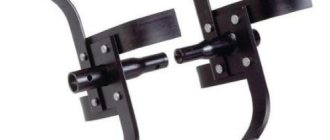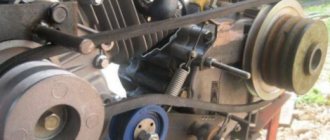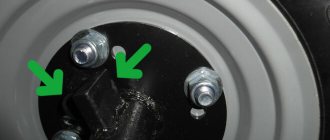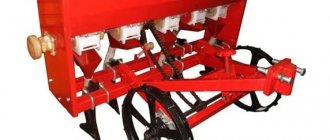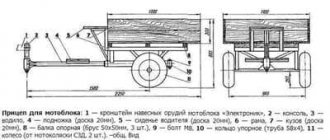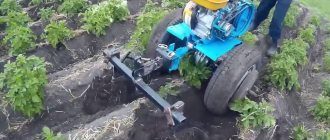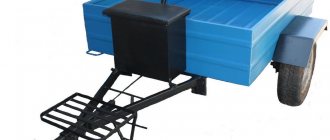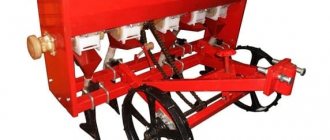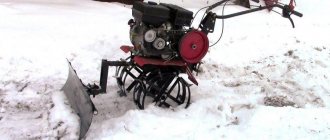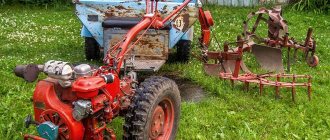The walk-behind tractor is a single-axis mechanical device with an engine. Its main functional purpose is to help people in various types of agricultural work. Therefore, every lover of gardens and vegetable gardens larger than 10 acres of land is obliged to make friends with this small-sized tractor, since you cannot find a better assistant.
Since high-quality components are important in technology, everyone who works with it must not only learn their names, but clearly understand their purpose in a complex mechanism and know which of the parts is secondary and which takes on the main functions.
Monitor the integrity of the Pulley in your walk-behind tractor
Pulley image in the drawings
From the drawing of the product, its structure, dimensions and manufacturing method should be completely clear.
For standard products, the designation of the pulleys must be indicated on the drawing. In order to correctly and accurately manufacture a non-standard pulley, its drawing must meet certain requirements. You can choose the correct angle of the pulley groove if you use a standard series of slopes for the drawing.
The pulley is usually depicted in drawings in two forms:
- section by a secant plane passing through the axis of rotation;
- side view.
The side view, as for other parts with axial symmetry, is not shown in full, but in half. For pulleys that have spokes in their design, it is permissible not to depict everything, but to provide a drawing of one part indicating their number.
The incision must be constructed so that there is at least one spoke in its plane. There is no need to hatch the spokes on the section. If the part is made solid, the cut plane is hatched, as usual in the drawing.
Main dimensions and parameters, such as:
- rim and hub diameter;
- V-belt profile;
- mating radii;
- groove slopes, etc., are marked on the cut.
An additional view of the drawing shows a cross-section of a spoke. If its shape is variable, then several additional types of drawing are made.
An image of the mounting location for the key with dimensions and an indication of the surface quality is also shown in an additional view of the drawing.
If instead of knitting needles, to facilitate the construction, several holes are provided in the body of the part, their number and dimensions are indicated on the section, and it is permissible not to construct a side view in the drawing.
Walk-behind tractor pulley: characteristics, manufacture and operation
Auto mechanic, specializes in agricultural equipment
The walk-behind tractor is a single-axis mechanical device with an engine. Its main functional purpose is to help people in various types of agricultural work. Therefore, every lover of gardens and vegetable gardens larger than 10 acres of land is obliged to make friends with this small-sized tractor, since you cannot find a better assistant.
Since high-quality components are important in technology, everyone who works with it must not only learn their names, but clearly understand their purpose in a complex mechanism and know which of the parts is secondary and which takes on the main functions.
Monitor the integrity of the Pulley in your walk-behind tractor
Pulley on a walk-behind tractor: rules of care and operation
For long-term use of both factory and homemade pulleys and reducing the number of their repairs, you should:
- monitor the serviceability of the pulley fastenings on the motor and prevent them from loosening;
- before putting the walk-behind tractor into operation, the driven or driving pulley must be checked for deformations;
- promptly remove plaque, dirt and other foreign elements from both the casing and the pulleys;
- follow safety precautions.
vote
Article rating
Operation and maintenance of Neva MB-2
Changing the engine oil
The manufacturer recommends using such well-known brands of motor oil for the walk-behind tractor as LUKOIL - standard SAE 10W30 API SF/CC, as well as RAVENOL SAE 30 API CD/SF.
At temperatures above 4 degrees Celsius, using thickened types of oils (for example, 10W30 brand) will lead to increased consumption of this type of fuel, so in the cold season it is recommended to check the engine oil level more often, preventing its level from dropping below normal.
The oil change is carried out after the walk-behind tractor has recently been in operation, while the engine has not yet completely cooled down. It should be warm, but not hot. The remaining oil is completely drained from the tank, after which new oil is added until the oil level reaches a special mark. The drain plug is then tightened tightly and wiped dry.
First launch and testing of the Neva MB-2 walk-behind tractor
The first start must be carried out according to the following scheme:
- make sure that the walk-behind tractor is in complete condition (the height of the steering bar and handles must correspond to the user’s height);
- You can start the engine only if the walk-behind tractor is located on a flat surface;
- check the oil and fuel levels in the tank;
- also check the places of threaded connections;
- then you can start the engine by smoothly turning the ignition knob;
- The idle time (without load and movement) should be about 10 minutes, then you can move and operate the walk-behind tractor.
The break-in period is considered to be the first 20 hours of operation of the walk-behind tractor, after which it is necessary to change the oil
During this period it is most important:
- do not operate at full throttle;
- work only on pre-prepared soils (not virgin soil);
- for cultivation, use only the number of cutters that are included in the kit;
- The Neva MB-2 walk-behind tractor can only be loaded at ¾ power during the run-in period;
- gear shifting in the gearbox can only be done when the rotation of the drive pulley has completely stopped;
After the first 20 hours of operation after the first start, the engine oil should be changed.
Characteristics and areas of application of pulleys for walk-behind tractors
One of the main and very important parts in a walk-behind tractor is the pulley. This spare part is responsible for the directions of force produced by the motor. Through the belt, the energy emanating from the engine through the pulley of the walk-behind tractor is transmitted to the mounted mechanisms of the walk-behind tractor, which, in turn, ensures control of their rotation and the movement of the entire walk-behind tractor as a whole.
There is a certain classification of these products. They are distinguished:
- by size;
- according to the material from which the pulley on the walk-behind tractor is made;
- by type of part manufacturing;
- according to the shape of the holes for landing on the main engine shaft;
- relative to the shaft to which the spare part belongs.
Let's look at each aspect in more detail.
Regarding the material from which such an irreplaceable part as a pulley is made, aluminum, steel, cast iron, stainless steel, duralumin and even plastic are often used. Such options are particularly practical and durable, which significantly extends the life of the entire walk-behind tractor.
It is very important that the part made from the above materials is very resistant to environmental conditions
In this video we will look at a pulley for a walk-behind tractor:
According to the type of manufacturing of parts, disc pulleys, pulleys with spokes and monolithic are distinguished, which, in turn, are divided into two- and three-strand (the difference between them is in diameters).
The shape is determined by the type of hole for landing - there are products with cylindrical and cone-shaped holes. Both types have eight special recesses, on which the serviceability of the belt, and therefore the efficiency of the entire walk-behind tractor, directly depends. Also, in order to protect the walk-behind tractor from breakdowns and damage, before installing the pulley on the gearbox of the walk-behind tractor engine, it is necessary to select a belt of the ideal size.
With respect to the shaft to which the pulley belongs, driving and driven elements are distinguished. The difference between them is that the slave is installed directly on the crankshaft, while the master is connected to the motor and, using the energy generated by it, drives the attachments on the walk-behind tractor.
Selection and use of pulleys for a walk-behind tractor
For many decades, agricultural workers have been using a walk-behind tractor, which greatly facilitates heavy work on the ground. This device helps not only to plow, but also to harrow, harrow and hill. An electrical apparatus consists of a large number of main and auxiliary parts. One of the important parts of the walk-behind tractor is the pulley, which transmits rotating speed from the motor to the attachment through a belt. This device allows the device to move in different directions. In specialized stores you can see pulleys that differ not only in size, but also in the material of manufacture. Before purchasing the necessary part, you should consult with experienced craftsmen or store consultants so that the purchased part does not turn out to be unnecessary and useless.
Installation of a Chinese engine on a Ural walk-behind tractor
Greetings dear forum members. There is a similar topic here somewhere, or rather it is generally about the Urals, and in it the topic of engine replacement is touched upon without any specific examples (except perhaps for a few videos on YouTube, where a specific installation is briefly covered without details and with advertising). I got the gist from it, but some details remained questionable. Here I will outline my installation experience, not without your help, of course. At the moment there is a Ural walk-behind tractor with an almost inoperative EVP engine/
A single-stage reduction gearbox was purchased for engines with a 19.05 mm shaft
A Green Field GF-170FE 4-stroke gasoline engine has been ordered (with an electric starter, this is my father’s requirement, since it is calculated that the walk-behind tractor will be used with a cart for trips to pick up grass for rabbits)))
Now the matter remains with the pulley for the gearbox and belts. But I will buy belts after installing the engine, fortunately in the city there is a factory for the production of rubber products UZEMIK and a company store attached to it, choosing belts will not be a problem. It's not entirely clear with the pulley. The original pulley from the Urals has a 32mm shaft fit. The shaft of the new gearbox is 15mm. Making a spacer is not difficult. But... I found a passport for the Ural walk-behind tractor on this forum, one of the forum members scanned it, for which I thank him very much. So, the speed of the gearbox shaft at 1 speed is about 300 rpm, at 2,600 rpm. The speed of the Chinese engine is up to 3600 rpm, with a new gearbox 1800 rpm, i.e. somewhere 3-6 times more than necessary (provided that the original pulley from the Urals is installed), i.e. change the pulley too. For now there are two options - order a new one, or get one from a Mole motor-cultivator, like this
Unfortunately, I haven’t measured the dimensions of the original pulley, and I also can’t find the dimensions of the Mole pulley, so I’m still in creative search. I would be very grateful to everyone for useful thoughts or experience in this homemade product. P.S. The engine will be installed in any case, I will make detailed instructions on what I did and how, so that people don’t suffer like I did in finding the necessary material...
Pulley concept
It is designed to transmit torque from the drive shaft to the driven shaft. To operate such a drive, both shafts are placed in parallel. A flat wheel is put on and secured to each shaft; they are placed in the same plane. The wheels are connected by an endless flexible drive belt. When the drive pulley rotates, the friction force causes the belt to move, covering part of its surface. This motion is transferred to the driven pulley, causing it to rotate.
Belt drives are common among household appliances, mechanisms of low- and medium-power machine tools, and in various internal combustion engines.
It has the following advantages:
- simple device;
- the ability to transmit significant power, modern V-belt pairs transmit up to 400 kW;
- high rotation speed, up to 50 m/s;
- smooth and quiet running;
- damping of vibrations and jerks of the drive shaft during rotation transmission;
- slippage under overloads acts as a safety mechanism.
The pulley itself is a disk on a shaft. It consists of two main parts: the rim and the hub. The rim is the outer part of the part. It engages with the belt and, depending on the type of drive, can be flat or have a recess in the shape of the belt. The side projections above the rim are called cheeks. They keep the belt from slipping. If the drive is wedge, then the cheeks are made inclined; they have an additional function - they increase the engagement area.
If a gear drive is used, then teeth of the appropriate shape are made on the surface of the rim.
If several streams are used in parallel, several grooves are made on the rim.
The hub is the inner part of the pulley. It has a hole for mounting on the shaft. Often the rim and hub are cast, turned, or milled as a single piece.
To reduce the weight of the product, voids are left in the body of the pulley, forming spokes. When made from wood, the presence of knitting needles was determined by the manufacturing technology.
To ensure the interchangeability of pulleys, their standard sizes, technological requirements, and markings are standardized. They are described in GOST 20889-94. “Pulleys for driving V-belts” and in GOST R 50641-94 (ISO 4183-89).
Standard markings include the following parameters:
- number of streams;
- profile of the drive belt used;
- diameter (calculated by cord);
- sleeve designation.
Thus, the marking 8 SPC 500 indicates an eight-lane pulley for an SPC profile with a diameter of 500 mm.
The rules for depicting pulleys in the drawing have also been standardized. The drawing must be constructed so that the product can be manufactured to exactly the same shape and size.
Purpose and technical characteristics of pulleys
A pulley for a walk-behind tractor is an important part of the gearbox, which is responsible for the direction of the force coming from the motor. It is with its help that the unit can move forward or backward and operate attachments. A pulley is attached to the main shaft of the engine and transmits force to the required wheel using a belt.
Pulleys differ in size and material from which they are made. The most reliable and durable option is a pulley made of duralumin, cast iron, steel or aluminum. They are quite durable and resistant to the external environment.
Based on the type of manufacture, there are 3 types of pulleys suitable for walk-behind tractors:
- disk – with a diameter of 80-400 mm;
- pulley with spokes – diameter 180-1000 mm;
- monolithic - include two-handle pulleys (25 mm in diameter), as well as three-handle pulleys (100 mm in diameter).
As for the shape of the holes for landing, according to this criterion, pulleys with a cone-shaped and cylindrical hole are distinguished. Both types of pulleys are equipped with 8 special grooves, which must be carefully maintained in working condition and regularly ground to protect the belts from premature wear.
Application of pulleys
Wedge drives are one of the most widely used in a wide variety of mechanisms and devices with high torque and angular velocity. First of all, these are internal combustion engines. In addition, V-belt pairs are used in areas such as:
- fans and air conditioners;
- compressor units, both piston and screw;
- transport systems of buildings: elevators, escalators, travelators;
- agricultural machinery;
- road construction equipment;
- mining machines;
- industrial technological installations;
- machines;
- Appliances;
- hand power tools;
and in many other industries.
Gear drives are used in cases where it is necessary to transmit significant torque without slipping. The toothed belt drive does not require much tension for good traction. It produces significantly less radial load on the axle than other belt drives.
The following drives are used in:
- automobile engines, for the gas distribution mechanism;
- power drives of machine tools and industrial mechanisms;
- in technological installations of the food, pharmaceutical, chemical industries.
Poly V-ribbed pulleys do an excellent job in so-called serpentine transmissions, when one drive supplies rotational energy to many consumers, and at the same time follows a very winding trajectory. Poly V-ratio transmissions allow you to transmit significant torques and achieve high speeds without increasing dimensions.
They are used both in heavy engineering and in the production of household appliances.
CVT drive wheels are used wherever it is necessary to smoothly change speed and torque without stopping rotation or removing the load. They are popular in areas such as:
- transmissions of cars, motorcycles, and other wheeled vehicles;
- conveyors;
- precision machines for processing metal, wood and other materials;
- agricultural machinery.
A modern variator surpasses both manual and hydraulic transmissions in its performance characteristics.
Flat drives are used where it is necessary to transmit rotation over significant distances (up to 7-9 m) and absorb shocks, jolts and other dynamic loads transmitted from the drive shaft to the driven shaft (or in the opposite direction). They apply:
- in pressing and other forging equipment;
- in sawmill drives;
- in technological equipment of the textile industry;
- in powerful centrifugal pumps.
Round belt drives are used for light-duty transmissions in precision instruments, consumer electronics and appliances.
They also easily intersect and, with the help of additional passive pulleys, allow you to connect the driven and drive shafts, located in different planes and at an angle to each other, and also change the direction of rotation.
Description
In walk-behind tractors, designers use a belt drive, which consists of two pulleys, a belt and a tensioner.
Advantages:
- high speed;
- protection of drive units from overheating;
- simplicity;
- reliability;
- low cost;
- no noise.
Flaws:
- frequent replacement of belts;
- pressure on shafts and supports.
The pulley is the main part of the gearbox, which is located on the central shaft of the engine. The appearance of the part resembles the shape of a wheel and interacts with other elements through a special belt.
In specialized stores you can purchase these devices of different sizes. Most of the parts are made of aluminum, steel, cast iron and duralumin, and have high strength and reliability. To reduce the cost of goods, some manufacturers use plastic, plywood and textolite for production.
The main criterion when choosing a part is the size of the belt. The size of the pulley depends on it.
Technical requirements for belts:
- strength;
- wear resistance;
- minimal bending rigidity;
- maximum friction value on the pulley surface.
Types of belts:
- flat - have a small thickness and cross-section, during the manufacturing process they are glued together from separate parts of the fabric;
- woven - have a thickness of up to 1 cm and are made of nylon fabrics that are impregnated with polyamide and rubber;
- rubberized - made of anide cord and have a thickness of 10 mm;
- synthetic - have a thickness of up to 3 mm and a glued joint.
There are also round and V-belt types.
Varieties
Manufacturers produce three types of pulleys for walk-behind tractors:
- disk - have a size from 8 to 40 cm;
- with knitting needles - have a diameter from 18 to 100 cm;
- monolithic - two-strand ones have a size of 3 cm, and three-stranded ones have a size of 10 cm.
There are two types of mounting hole:
All pulleys have 8 grooves, the quality of grinding of which determines the wear rate of the working belt.
Types of pulleys depending on the type of gearbox:
For walk-behind tractors with attached equipment, it is necessary to purchase pulleys with a diameter of 19 mm, and for more complex high-speed machines you will need pulleys with a diameter of 13.5 cm.
Care
To extend the life of the walk-behind tractor, experts recommend knowing and applying several basic rules for caring for the pulley:
- regularly check and clean the protective casing from stones, dust particles, soil and other debris;
- constantly checking the reliability of fastening the part to the axle to prevent thread wear;
- compliance with all rules and regulations for the operation of electrical devices;
- checking alignment with a laser level;
- checking the device for mechanical damage, as well as cracks and scratches.
To prevent the development of corrosion processes after operation, it is necessary to place the walk-behind tractor in a dry and ventilated room, protected from various precipitation.
In order to remove the pulley and correct the starter's runout, you must first reduce the stroke, reduce the speed, and then completely stop the device.
Before starting the process of carrying out the planned work, it is necessary to check the serviceability of all elements of the walk-behind tractor to prevent the occurrence of unpleasant situations that could lead to breakdown of the entire walk-behind tractor.
Main activities of a comprehensive technical inspection:
- regular cleaning of all working units;
- checking air filters;
- regular replacement of deformed parts;
- checking spark plugs;
- oil change;
- lubrication of control system parts;
- clutch adjustment;
- muffler change;
- belt tension adjustment.
A walk-behind tractor is a universal device that is used not only by farmers, but also by ordinary residents who have personal plots. This unit is a multifunctional device that makes it possible to remove snow, mow grass and lawns, transport cargo, pump water and clean streets. To perform different types of work, simply change the attachments. This process takes a short period of time and has simple technology. Stable operation of the device is ensured by a large number of different parts. One of the most important elements in a walk-behind tractor is the pulley. A simple round part is the connecting link between the motor and the moving elements. The entire process of performing the work depends on the operation of the pulley.
To learn how to replace the gearbox and front hitch pulley on the Neva MB-2 walk-behind tractor, see the video below.
Self-production
If it is impossible to purchase a ready-made pulley, professional craftsmen advise making this part yourself.
To make a spline pulley at home, you need a lathe and a metal blank. For help, you can contact turning workshops, where professional turners will definitely help you turn the necessary part.
If it is impossible to get a metal blank, experts advise using a piece of plywood.
Required tools:
- electric jigsaw;
- milling cutter;
- compass;
- electric drill.
Manufacturing stages:
- purchasing the necessary workpiece;
- drawing a circle of the required diameter;
- drilling a central hole;
- cutting out a circle with a jigsaw strictly along the intended line with a distance of 20-25 mm from the line;
- grinding the resulting workpiece with fine sandpaper;
- cutting a groove for the belt using a cutter of the required size;
- installation of the finished product into a walk-behind tractor;
- eliminating all defects and inaccuracies.
This plywood part has a short service life and requires constant inspection and replacement if necessary.
You can install homemade parts only on those walk-behind tractors in which this manipulation is provided for by the developers.
To extend the life of the walk-behind tractor, experts recommend knowing and applying several basic rules for caring for the pulley:
- regularly check and clean the protective casing from stones, dust particles, soil and other debris;
- constantly checking the reliability of fastening the part to the axle to prevent thread wear;
- compliance with all rules and regulations for the operation of electrical devices;
- checking alignment with a laser level;
- checking the device for mechanical damage, as well as cracks and scratches.
Pulley for a walk-behind tractor engine: learning to make it yourself
In order to perform this seemingly difficult task at home and do without purchasing this part, there are a number of ways. We will focus on a few - the simplest and most universal ones, which will help replace a worn spline pulley both on walk-behind tractors of the Neva series and others - such as the Salyut and Centaur.
1st method
The trick of the first method is to directly turn the part using a previously made workpiece on a lathe. The absence of turning equipment at home is not an obstacle to the successful completion of the project, since turning products can be ordered from specialists at any time. If the pulley is of a large diameter, it may be difficult to find the workpiece.
2nd method
Requires more skill and perseverance.
The material and technical base of the homemade product will be:
- sheet plywood;
- power tools – drill, jigsaw, router.
Let's consider the sequence of work:
- we determine the diameter - information about the size of the pulley can be found in the operating instructions for the walk-behind tractor or by directly measuring the pulley removed from it;
- using a compass solution, measure the required length equal to the radius of the pulley;
- put it on the workpiece and draw a circle;
- take a jigsaw and cut out a circle;
- to eliminate roughness, grind the wheel with sandpaper;
- Mark a hole for the inner diameter of the pulley and drill it with a drill. To expand, we use a boli placed on a drill;
- We mill the place where the belt will be put on. For this purpose, the circle is fixed to the workbench with self-tapping screws, a cutter for a hand router is selected and a groove is made for the belt drive;
- Before installing the pulley, we take measurements of its seat directly in the engine compartment. Only after this can you start drilling the circle;
- We attach the pulley to the walk-behind tractor gearbox using a flange.
User manual
To protect your equipment from premature breakdowns, thereby avoiding unexpected expenses, both from a financial point of view and from the point of view of temporary resources, you should follow just a few simple rules for care and operation:
equipment cannot last forever only because most of it consists of durable steel, so protect the walk-behind tractor from sudden temperature changes, the influence of excessive humidity and dampness; regularly clean the top of the pulley from dust and other contaminants to avoid foreign particles getting into the part; make sure that the pulley is properly fastened to the engine axis, since the slightest vibration or loose fastening will lead to inevitable breakdown; If you notice the slightest scratch or crack on one of the parts, pay due attention to it. This way, you can protect your equipment from serious damage and ensure comfort and safety during its operation.
Rules for the care and operation of the pulley on the engine
For long and stable operation of the drive pulley, you should remember some rules for its care and use:
- Do not forget to regularly clean the pulley guards from foreign particles, dust and dirt. This will protect the part from getting dirt inside;
- check the fastening of the pulley on the engine axis. At the slightest loosening of the fasteners during vibration, the part will wobble, which will lead to serious damage and wear of the shaft;
- If serious chips, cracks and scratches appear on the surface of the part, do not delay replacing it. After all, a pulley failure during operation can have quite serious consequences;
- Protect the walk-behind tractor from excess moisture and do not store it in damp conditions. This can lead to severe corrosion and, consequently, to pulley failure.
Making a pulley with your own hands
There are several methods that allow you to independently make a splined pulley for a walk-behind tractor. The easiest way is to grind the part. To do this, select a suitable workpiece and process it on a lathe. If you do not have a specialized machine at your disposal, you can order the production of the part at a turning workshop. However, it should be taken into account that the pulley for a walk-behind tractor is a fairly large element, so it will be quite difficult for the master to find a suitable workpiece for turning the element. In this case, you can make the pulley yourself, and order a flange for it from a workshop.
The second method is more difficult to implement. To work, you need to prepare a sheet of plywood, an electric jigsaw, a drill and a hand router in advance. The procedure is as follows:
- First of all, cut a piece of suitable diameter from plywood;
- Take a compass and draw a circle on the workpiece. Make a hole in the center of it;
- Using an electric jigsaw, cut out the disc. In this case, the distance from the edge of the disk to the outer line of the plywood should be approximately 2–3 cm;
- To give the cut disk a perfectly round shape, attach a drill with a bolt pre-attached to the drill in its central hole, and sand the workpiece using fine-grained sandpaper;
- Next, form the place where the belt will be tensioned. This is very easy to do using a hand router. Securely fix the disk on the workbench using self-tapping screws, and select a groove for the belt, having previously selected a cutter suitable for the job;
- After making the pulley, take measurements of its seat on the motor shaft and drill a hole of the required diameter inside the part.
The finished part can be installed on a walk-behind tractor. When operating the unit, remember that a plywood pulley will not last for a long time, so check it regularly for damage or deformation. When the first defects appear, immediately replace the pulley with a new element.
How to make a pulley for a walk-behind tractor with your own hands?
You can make your own spline pulley for a walk-behind tractor using 2 methods.
The first method is simpler. It is necessary to select a steel blank of the required size and turn a pulley from it on a lathe. You can do this yourself (if you have the necessary equipment and skills) or in special workshops.
The second method is a little more complicated, and the durability and strength of a pulley made using this method will be significantly lower. But as a temporary replacement in emergency cases, this option is quite suitable.
Before starting work, you need to select a piece of durable plywood, a jigsaw, a drill, and a router.
The manufacturing process itself follows the following algorithm:
- Cut a piece of plywood to the required size.
- Draw a perfectly even circle on the workpiece and drill a hole exactly in the middle.
- Use a jigsaw to cut out a disc in the workpiece. Calculate the dimensions of the disk so that at least 3 cm remains from its edge to the edge of the workpiece.
- To polish the edges of the cut disk to a perfectly smooth state, pass a drill through the hole in the center (it is advisable to put a bolt on the drill). The workpiece placed on the drill is ground using fine sandpaper.
- Using a router, make a recess in the workpiece for the belt. Before starting work, make sure that the cutter will make the optimal recess.
- Measure the diameter of the shaft for fastening and make a corresponding hole in the center of the workpiece.
We also invite you to watch the video, which demonstrates the process of making a pulley from plywood yourself:
After installing the pulley, regularly monitor its technical condition. Such a homemade pulley is perfect for many modifications of walk-behind tractors from such well-known brands as Salyut, Neva, Agro, etc.
What is a PTO on a walk-behind tractor - description and functions
A power take-off shaft is an element that is necessary for installing various types of attachments on a walk-behind tractor. Walk-behind tractors with a power take-off shaft allow the use of such types of attachments as mulchers, seeders, harrows, stump grinders, mounted mowers, as well as attachments installed directly into the trailers used for work.
The main function of the power take-off shaft is to receive and transmit rotational forces from the engine to the attachment. In most cases, this important element is located at the rear of the walk-behind tractor, which allows you to connect almost all known types of attachments to it.
Among the main advantages of the power take-off shaft are its versatility, high strength and reliability. In addition to the advantages, the PTO has several significant disadvantages, which include the large weight of the element and the need to use an additional gearbox with it.
